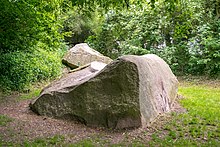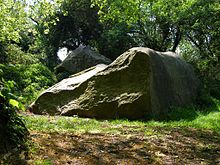Johannis stones (Lage (Lippe))
The Johannissteine are a group of boulders in the area of the Lippe town of Lage .
The mighty erratic granite blocks were pushed to their present location by glaciers from the Saale Ice Age 200,000 to 125,000 years ago and are entered as a nationally important geotope under number 2.3-16 in the “ List of natural monuments in Lage ”.
location
The Johannissteine are located around one and a half kilometers southeast of the town center of Lagens, south of “ Detmolder Straße ” ( Bundesstraße 239 ) towards Orbke / Detmold , in the extension of the “ An den Johannissteinen ” road in the Lippe district of North Rhine-Westphalia in Germany .
description
The largest of the three actual Johannis stones , " Stone 1 ", is 6.20 meters long, 5.50 meters wide and has an estimated weight of around 104 tons with a volume of around 39 cubic meters. It lies exactly in a north-south direction.
" Stone 2 " (5.2 × 3.0 × 2.3 m) lies at right angles to " Stone 1 ", " Stone 3 " (4.0 × 2.7 × 2.1 m) lies southwest of the two large stones ; in the wider area there are small boulders and fragments.
In 1990 the Johannis stones were declared a ground monument.
origin
It is very likely that the Johannis stones come from the Åland Islands in the northern Baltic Sea , between Sweden in the west and the Finnish mainland in the east. As early as 1926, the origin was determined by so-called thin section examinations at the universities of Greifswald and Münster and the Swedish University of Uppsala .
Place of worship / calendar
All three large stones have a total of 15 carvings (symbols such as heart, pentagram, notches, circles) as well as 13 drill holes and channels.
Three exact pentagonal holes in " Stone 1 " allow the precise localization of the winter solstice with the use of sticks . The other seasonal turning points can also be determined from the Johannis stones, so that the Johannis stones probably served as a kind of calendar in pre-Christian times. The holes could have been made between 500 and 100 BC.
See also
literature
- Johannissteine - a prehistoric place of worship? , Flyer from the tourist information office Lage, Lage, June 2001.
- Johannissteine - a (pre) prehistoric calendar system? , Flyer from the tourist information office Lage, Lage, June 2001.
- Erich Neumann and Wolfgang Lippek: Johannis stones near Lage an early historical place of worship? . In: Heimatland Lippe, February 1981, p. 44ff.
Web links
- How the boulders came to Westphalia , Landschaftsverband Westfalen-Lippe , Münster
- Johannisstein research
Individual evidence
- ↑ Karl-Heinz Otto: How the boulders came to Westphalia at www.lwl.org, accessed on May 11, 2020.
- ↑ Location map of the Johannissteine at www.johannissteinforschung-lage.de, accessed on May 10, 2020.
- ↑ Erich Neumann and Wolfgang Lippek: Johannis Stones near Lage an early historical place of worship? . In: Heimatland Lippe, February 1981, p. 44ff, accessed on May 10, 2020.
- ↑ Johannissteine - a prehistoric place of worship? , Flyer from Tourist Information Lage, Lage, June 2001, accessed on May 10, 2020.
Coordinates: 51 ° 58 ′ 47.8 " N , 8 ° 48 ′ 34.7" E



